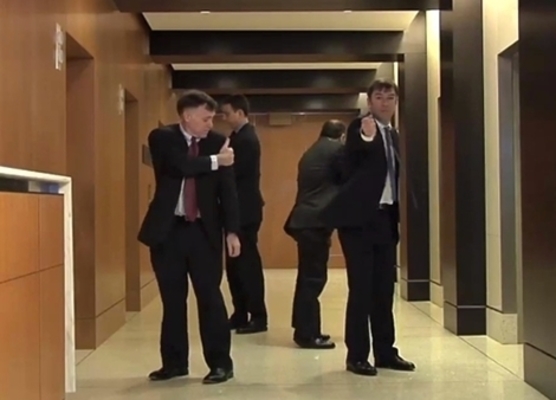
Description
On loan from the Museum of Fine Arts, the video “Sloss, Kerr, Rosenberg, & Moore” was made with four practicing, successful New York City litigators. Highly formal in its spatial design and patterning, the performance becomes a twenty-first century folk dance. Four lawyers perform charismatically a movement and vocal score that references their work and lives, transforming a banal corporate office space into an exciting performance space. Visitors will be able to sit and watch the video, as if they are in a jury or in some civic space.
Collection Museum of Fine Arts, Boston. Museum purchase with funds donated by Robert and Jane Burke, Davis and Carol Noble, Steven Rogowski, and The Living New England Artist Purchase Fund, created by The Stephen and Sybil Stone Foundation, 2008
2008.119
@mfaboston
#mfaboston
#ILLUMINUSboston
#HUBweek
#ArtLifeBoston
MARY ELLEN STROM
Working primarily in video, Mary Ellen Strom uses drawing, painting, sculpture and dance to unearth submerged narratives in the environment, history, and in cultural discourse. Her individual installations and collaborative projects have been exhibited at The Museum of Fine Arts Boston, the DeCordova Museum, Lincoln, MA, Museum of Modern Art, NYC, the Currier Museum, Manchester, NH among others. Strom has participated in residencies including PS1/MoMA, Lower Manhattan Cultural Council, The International Studio and Curatorial Program, among others. Strom is on the faculty of the School of the Museum of Fine Arts, Boston.
CURATOR'S STATEMENT
CAMILLO ALVAREZ
Sloss, Kerr, Rosenberg & Moore is a single-channel video whose choreography existed as a live performance piece created in 1986 by Ann Carlson. The video features four practicing New York City attorneys John Sloss, Chet Kerr, Scott Rosenberg and Thomas Moore, performing a movement and spoken word score that alludes to tasks associated with their job and life. Some choreographed references include litigating, pressures of the judicial system, the contest, the service and the lawyer’s subjective view of their work. The piece addresses labor traditions of white collar workers in both a critical and humorous way, with formally designed choreography alongside unexpected, patterned vocals. The artists are interested in using choreography to comment on ideologies of time-honored American jobs and their effects on the human body, creating a kind of modern day ritual dance.
Details
- Location:
- Lower Parking
- Credit Line:
- Project presented courtesy of the MUSEUM OF FINE ARTS, BOSTON

